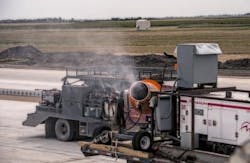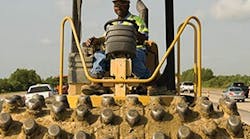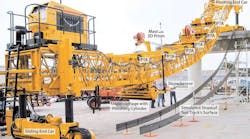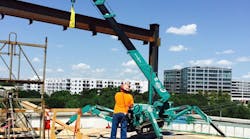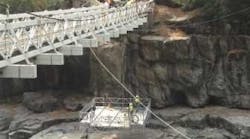Strata Corp., an experienced builder of military and commercial airfields, used an innovative method for retaining moisture in the concrete of an immense paving project to optimize curing and surface durability. When reconstructing the 2.5-mile, 450,000-square foot runway at Minot Air Force Base, Ward County, N. D., Strata employed atomized misting equipment from Dust Control Technology (DCT), Peoria, Ill., to raise humidity around freshly poured concrete, thus allowing adherence to strict U.S. Army Corps of Engineers (CoE) specifications.
“This installation involved slip-form paving 18 inches thick,” says Chad Erickson, Strata general manager of concrete operations. “During placement, the concrete needed to maintain its free moisture to ensure maximum hydration of the cement particles, which produces a more durable concrete.”
CoE specifications require concrete-curing temperatures of less than 90F, with an allowable maximum of 85F when humidity is between 40 and 60 percent, and 80F when humidity is below 40 percent. Although Strata treated the surface with a pigmented compound after finishing and texturing, concern about achieving proper curing conditions remained.
“The concern was over moisture loss during the finishing and texturing process on hot, dry days,” says Erickson. “But it’s unacceptable to spray the surface directly with water, because water directly applied to the concrete and finished into the surface results in much less durable concrete that is susceptible to defects.”
Strata’s quality-control manager, Phil Clouse, suggested using DCT’s DustBoss equipment, which is designed for open-area dust suppression by producing millions of atomized droplets per minute from special brass nozzles and launching the droplets over long distances with a powerful fan. Strata mounted two DustBoss DB-30 units on a generator-equipped trailer pulled by a water truck. The units produce airflow of 9,200 cfm and have an adjustable throw angle of 0 to 50 degrees, standard oscillation of up to 70 degrees, and a range of up to 100 feet, allowing coverage of 5,500 square feet from a 0.625-inch-diameter hose.
“The DB-30s did a good job of significantly increasing humidity behind the paver,” says Clouse. “There were times that we recorded an increase of as much as 15 percent.”
